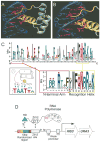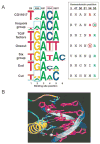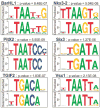Analysis of homeodomain specificities allows the family-wide prediction of preferred recognition sites
- PMID: 18585360
- PMCID: PMC2478728
- DOI: 10.1016/j.cell.2008.05.023
Analysis of homeodomain specificities allows the family-wide prediction of preferred recognition sites
Abstract
We describe the comprehensive characterization of homeodomain DNA-binding specificities from a metazoan genome. The analysis of all 84 independent homeodomains from D. melanogaster reveals the breadth of DNA sequences that can be specified by this recognition motif. The majority of these factors can be organized into 11 different specificity groups, where the preferred recognition sequence between these groups can differ at up to four of the six core recognition positions. Analysis of the recognition motifs within these groups led to a catalog of common specificity determinants that may cooperate or compete to define the binding site preference. With these recognition principles, a homeodomain can be reengineered to create factors where its specificity is altered at the majority of recognition positions. This resource also allows prediction of homeodomain specificities from other organisms, which is demonstrated by the prediction and analysis of human homeodomain specificities.
Figures







Comment in
-
A lexicon for homeodomain-DNA recognition.Cell. 2008 Jun 27;133(7):1133-5. doi: 10.1016/j.cell.2008.06.008. Cell. 2008. PMID: 18585344
Similar articles
-
Interchange of DNA-binding modes in the deformed and ultrabithorax homeodomains: a structural role for the N-terminal arm.J Mol Biol. 2002 Nov 1;323(4):665-83. doi: 10.1016/s0022-2836(02)00996-8. J Mol Biol. 2002. PMID: 12419257
-
The solution structure of the native K50 Bicoid homeodomain bound to the consensus TAATCC DNA-binding site.J Mol Biol. 2006 Mar 10;356(5):1137-51. doi: 10.1016/j.jmb.2005.12.007. Epub 2005 Dec 22. J Mol Biol. 2006. PMID: 16406070
-
Structure of the even-skipped homeodomain complexed to AT-rich DNA: new perspectives on homeodomain specificity.EMBO J. 1995 Dec 15;14(24):6280-91. doi: 10.1002/j.1460-2075.1995.tb00318.x. EMBO J. 1995. PMID: 8557047 Free PMC article.
-
Homeodomain interactions.Curr Opin Struct Biol. 1996 Feb;6(1):62-8. doi: 10.1016/s0959-440x(96)80096-0. Curr Opin Struct Biol. 1996. PMID: 8696974 Review.
-
Review: borders, patterns, and distinctive families of homeodomains.J Assist Reprod Genet. 1994 May;11(5):244-69. doi: 10.1007/BF02214344. J Assist Reprod Genet. 1994. PMID: 7711388 Review.
Cited by
-
Widespread evidence of cooperative DNA binding by transcription factors in Drosophila development.Nucleic Acids Res. 2013 Sep;41(17):8237-52. doi: 10.1093/nar/gkt598. Epub 2013 Jul 11. Nucleic Acids Res. 2013. PMID: 23847101 Free PMC article.
-
Transcriptional Networks Controlled by NKX2-1 in the Development of Forebrain GABAergic Neurons.Neuron. 2016 Sep 21;91(6):1260-1275. doi: 10.1016/j.neuron.2016.08.020. Neuron. 2016. PMID: 27657450 Free PMC article.
-
Identification of in vivo Hox13-binding sites reveals an essential locus controlling zebrafish brachyury expression.Development. 2021 Jun 1;148(11):dev199408. doi: 10.1242/dev.199408. Epub 2021 Jun 1. Development. 2021. PMID: 34061173 Free PMC article.
-
Inhibitory activities of short linear motifs underlie Hox interactome specificity in vivo.Elife. 2015 Apr 14;4:e06034. doi: 10.7554/eLife.06034. Elife. 2015. PMID: 25869471 Free PMC article.
-
Tlx3 Exerts Direct Control in Specifying Excitatory Over Inhibitory Neurons in the Dorsal Spinal Cord.Front Cell Dev Biol. 2021 Apr 29;9:642697. doi: 10.3389/fcell.2021.642697. eCollection 2021. Front Cell Dev Biol. 2021. PMID: 33996801 Free PMC article.
References
-
- Ades SE, Sauer RT. Specificity of minor-groove and major-groove interactions in a homeodomain-DNA complex. Biochemistry. 1995;34:14601–14608. - PubMed
-
- Benos PV, Lapedes AS, Stormo GD. Probabilistic code for DNA recognition by proteins of the EGR family. Journal of molecular biology. 2002;323:701–727. - PubMed
-
- Bergman CM, Carlson JW, Celniker SE. Drosophila DNase I footprint database: a systematic genome annotation of transcription factor binding sites in the fruitfly, Drosophila melanogaster. Bioinformatics (Oxford, England) 2005;21:1747–1749. - PubMed
-
- Berman BP, Pfeiffer BD, Laverty TR, Salzberg SL, Rubin GM, Eisen MB, Celniker SE. Computational identification of developmental enhancers: conservation and function of transcription factor binding-site clusters in Drosophila melanogaster and Drosophila pseudoobscura. Genome Biol. 2004;5:R61. - PMC - PubMed
Publication types
MeSH terms
Substances
Grants and funding
LinkOut - more resources
Full Text Sources
Other Literature Sources
Molecular Biology Databases

